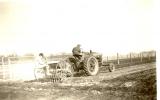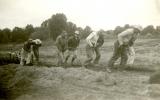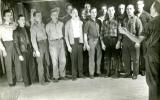CPS Unit Number 028-01
Camp: 28
Unit ID: 1
Title: Jasper-Pulaski
Operating agency: MCC
Opened: 4 1942
Closed: 5 1946
Workers
Total number of workers who worked in this camp: 506
-
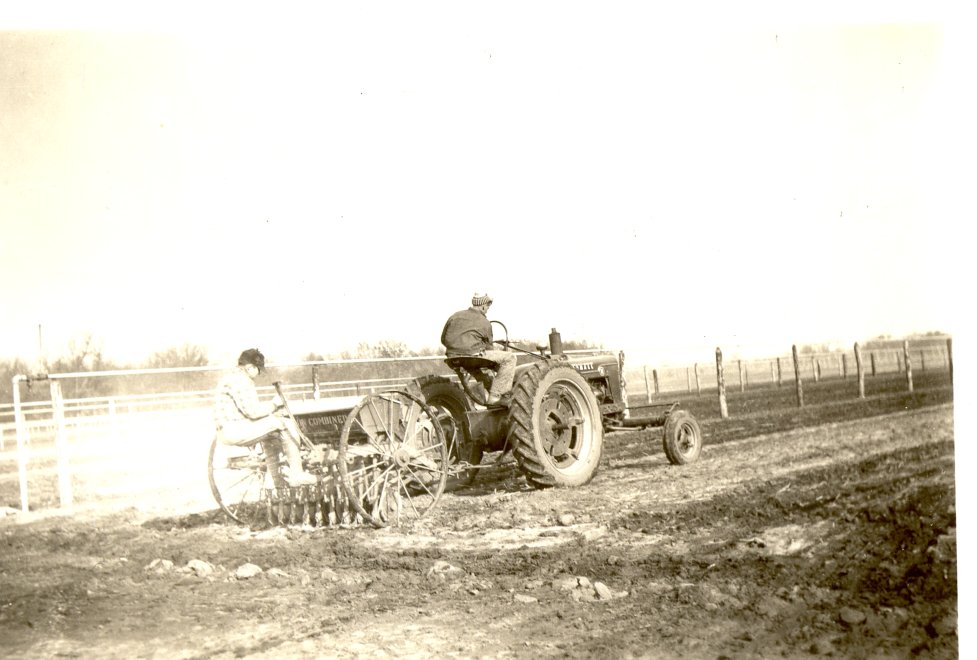 CPS Camp No. 28 Medaryville, IndianaCivilian Public Service camp 28, Medaryville, Indiana. Getting ready for planting see- Forestry.Box 1, Folder 18. MCC Photographs, Civilian Public Service, 1941-1947. IX-13-2.2. Mennonite Central Committee Photo Archive
CPS Camp No. 28 Medaryville, IndianaCivilian Public Service camp 28, Medaryville, Indiana. Getting ready for planting see- Forestry.Box 1, Folder 18. MCC Photographs, Civilian Public Service, 1941-1947. IX-13-2.2. Mennonite Central Committee Photo Archive -
 CPS Camp No. 28 Medaryville, IndianaCPS Camp No. 28, Medaryville, Indiana. An improvised pile driver - working on the banks of the Kaukakee River to prevent flood in high water.Photo #791. Box 1, Folder 18. MCC Photogrpahs, Civilian Public Service, 1941-1947. IX-13-2.2. Mennonite Central Committee Photo Archive
CPS Camp No. 28 Medaryville, IndianaCPS Camp No. 28, Medaryville, Indiana. An improvised pile driver - working on the banks of the Kaukakee River to prevent flood in high water.Photo #791. Box 1, Folder 18. MCC Photogrpahs, Civilian Public Service, 1941-1947. IX-13-2.2. Mennonite Central Committee Photo Archive -
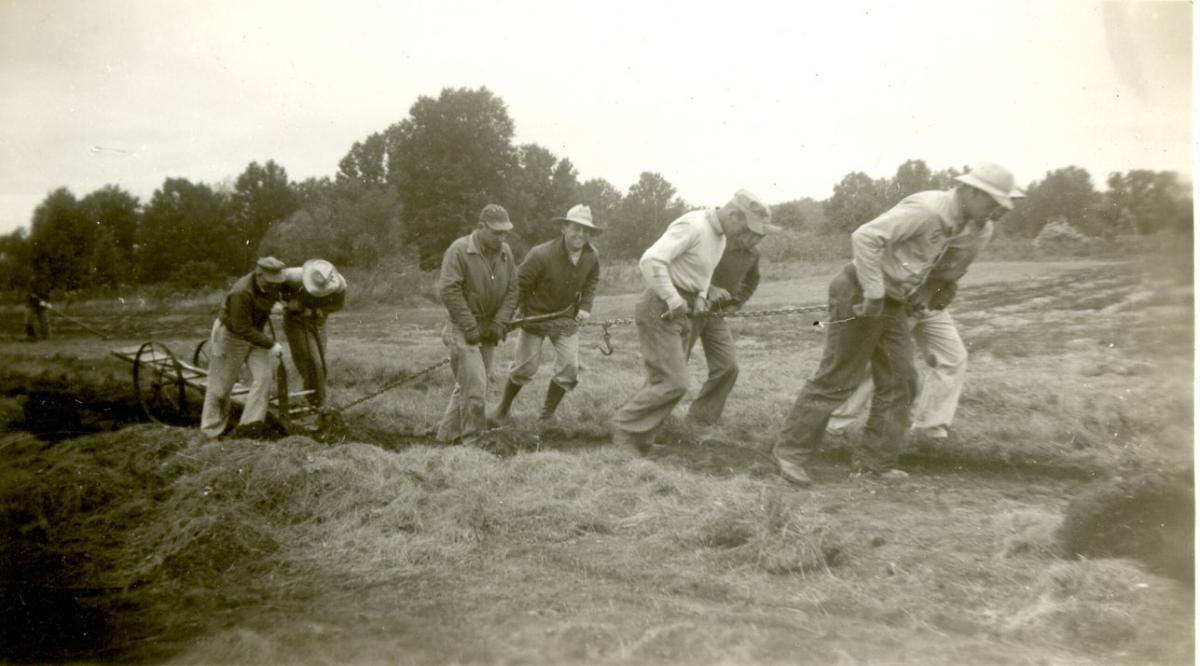 CPS Camp No. 28 Medaryville, IndianaCPS Camp No. 28, Medaryville, Indiana. A pull on the sod cutter.Photo #268. Box 1, Folder 18. MCC Photographs, Civilian Public SErvice, 1941-1947. IX-13-2.2. Mennonite Central Committee Photo Archive
CPS Camp No. 28 Medaryville, IndianaCPS Camp No. 28, Medaryville, Indiana. A pull on the sod cutter.Photo #268. Box 1, Folder 18. MCC Photographs, Civilian Public SErvice, 1941-1947. IX-13-2.2. Mennonite Central Committee Photo Archive -
 Chorus PracticeChorus practice with Alvin Shrock, DirectorMennonite Central Committee Historical Archives, Photographer, Charles Schumacher
Chorus PracticeChorus practice with Alvin Shrock, DirectorMennonite Central Committee Historical Archives, Photographer, Charles Schumacher
CPS Camp No. 28, a Forest Service base camp located on the Jasper -Pulaski Game Preserve five miles north of Medaryville, Indiana and operated by the Mennonite Central Committee, opened in April 1942 and closed in May 1946. The men planted trees in former strip mines and muddy areas of farms.
Directors: Raymond Hartzler, Melvin Funk, John Stalter, Richard Weaver
Dietician: Ruth Smucker, Ella Sanner
Nurse: Mary M. Mann
Matron: Mrs. Quintus Leatherman, Mrs. Raymond L. Hartzler, Mrs. Paul Bender
Nurse-Matron: Ophia Sevits
Many men came from rural areas. When entering CPS, most men in Mennonite camps reported affiliation with a variety of Mennonite denominational groups.
The majority of men in Mennonite camps entered CPS from farming or other agricultural occupations. On average, men in the Mennonite camps had completed 10.45 years of education, including twenty-two percent who had completed some college or graduated from college, or had taken post graduate work. (Sibley and Jacob pp. 171-72)
The men planted trees in former strip mines and difficult muddy and filthy areas of farms, often referred to as “muck farms”.
“We are on the eastern edge of the 5,000 acre forest in which there is a tree seedling nursery, specializing in coniferous stock, as well as large game farm on which quail and pheasants are grown for propagation purposes.” (Mennonite Central Committee CPS News Letter, May 1943) The next spring, the nursery shipped some 55,000 trees to parts of Indiana for planting in areas of strip mining, others to muck farms where they were planted as windbreaks. At that time 1.8 million trees were being replanted at roughly 100,000 per day.
The men helped raise thousands of birds for various Indiana conservation clubs. Merle E. Jacobs recalls “work at the Pulaski Game Reserve where I studied quail diseases and wildlife populations under a Pittman-Robertson Conservation Project.” (“Detour . . . Main Highway”: Our CPS Stories pp. 30-31)
The men performed emergency farm labor on potato and onion farms fifteen miles from the camp.
The men also performed fire prevention and control duties, while some held duties in camp maintenance and camp programs.
According to Gingerich, this unit experienced excellent public relations with the both the Forest Service agency staff and the community.
From April 1942 through March 1946, the men published a camp paper Peace Sentinel, a continuation of the paper published at Camp 13 in Bluffton, Indiana.
For more information on the work, life and programs in this camp see Melvin Gingerich, Service for Peace: A History of Mennonite Civilian Public Service. Akron, PA: Mennonite Central Committee printed by Herald Press, Scottdale, PA 1949, pp. 126-28.
For general information on CPS camps see Albert N. Keim, The CPS Story: An Illustrated History of Civilian Public Service. Intercourse, PA: Good Books 1990.
For personal stories of CPS men, see Peace Committee and Seniors for Peace Coordinating Committee of the College Mennonite Church of Goshen, Indiana, “Detour . . . Main Highway”: Our CPS Stories. Nappanee, IN: Evangel Press, 1995, 2000.
See also Mulford Q. Sibley and Philip E. Jacob, Conscription of Conscience: The American State and the Conscientious Objector, 1940-1947. Ithaca, NY: Cornell University Press, 1952.
Swarthmore College Peace Collection, Camp periodicals database.
